Argentinian Wine Region Guide [From Salta to Patagonia]
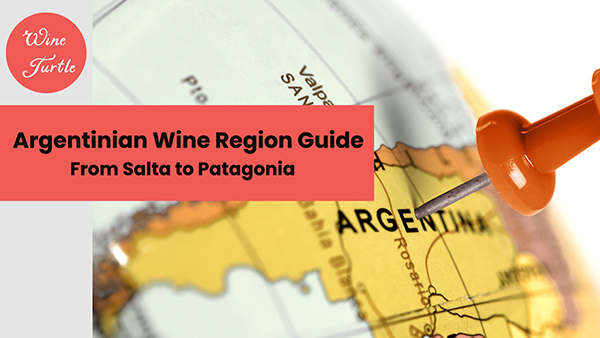
I sit here, sipping a glass of Malbec, my mind wanders to the vast vineyards of Argentina, a country that has captured my heart with its rich wine culture.
The allure of Argentinian wine regions is undeniable, with their unique terroirs and passionate winemakers.
From the high-altitude vineyards of Salta to the sun-drenched plains of Mendoza, each region tells a unique story through its wines.
In this guide, I'll do my best to explain the wine regions of Argentina and what makes them so special.
Argentinian Wine Facts
Before I explain the wine regions of Argentina, it might be of interest to take in some key facts about wine production in the country.
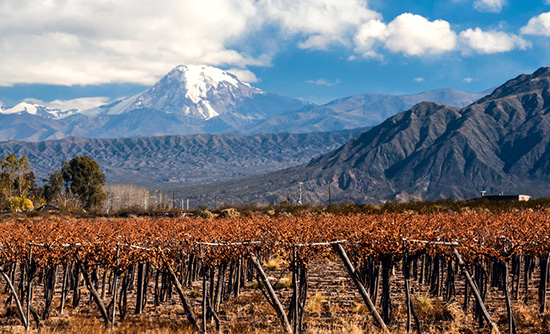
Brief History of Wine in Argentina
The history of wine in Argentina is rich and fascinating, with key events spanning centuries. To tell the whole story would be to write a book, so here are the main events condensed down as much as I could!
The history of Argentine wine dates back to the arrival of the first Spanish settlers in the 16th century.
It is believed that the first vine cuttings were brought by priests who needed wine for performing Catholic Mass. The cultivation of vines started in the regions of Santiago del Estero and Tucumán.
The 17th and 18th centuries saw the expansion of vine cultivation to the western part of the country, including Mendoza and San Juan, due to the favorable climate and irrigation possibilities offered by the Andes. The Jesuit priests played a significant role in this expansion.
The 19th century was a transformative period for the Argentine wine industry. Domingo Faustino Sarmiento, who later became the president of Argentina, hired French soil expert Miguel Aimé Pouget to bring new vine varieties from France.
This led to the introduction of Malbec, which would later become Argentina's flagship grape.
The late 19th and early 20th centuries saw a wave of Italian and Spanish immigrants arriving in Argentina, many of whom brought their winemaking traditions with them.
This period saw a significant expansion of vineyards and the establishment of many wineries that are still in operation today.
The late 20th century brought modernization to the Argentine wine industry, with the introduction of stainless steel fermentation tanks and the use of oak barrels for aging.
The 1980s and 1990s saw a significant increase in exports, particularly to the United States, and Argentine Malbec gained global recognition.
Today, Argentina is the fifth largest wine producer in the world and is known for its high-quality Malbec wines.
Map of Argentina's Wine Regions
If you're not familiar with the geography of Argentina, before you read about each region, here's a map of the wine regions that I'll discuss.
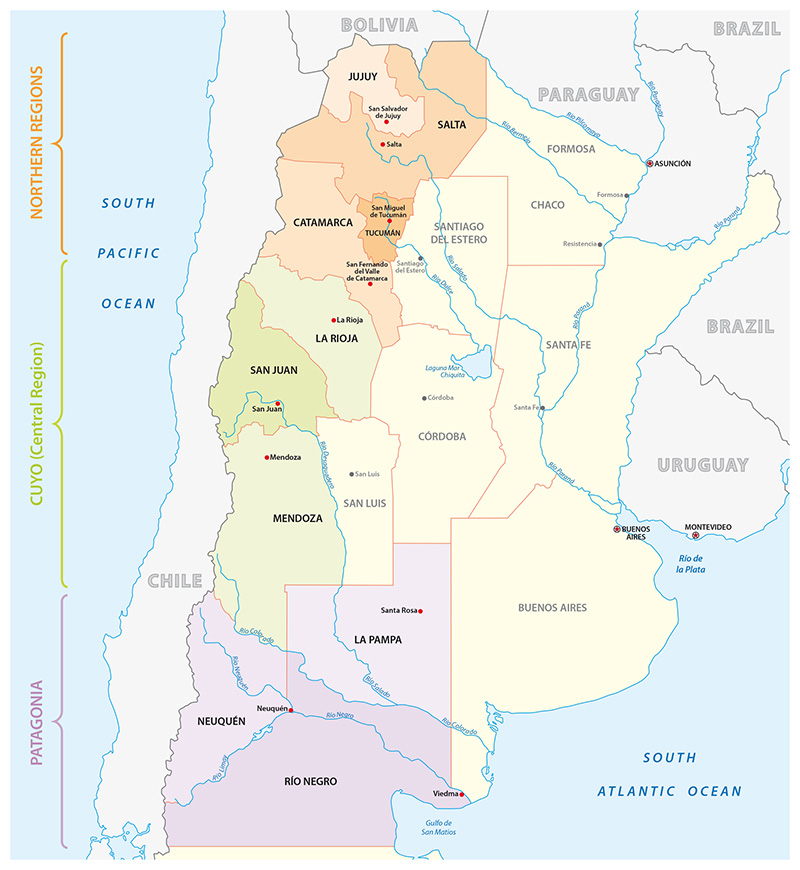
Exploring Argentina's Major Wine Regions
As we delve deeper into the heart of Argentina's wine country, we encounter a diverse array of regions, each with its unique characteristics.
Northern Argentina
Based at the foothills of the Andes in the west of Argentina, these wine regions produce some distinctive wines due to their unique location.
Salta
Salta is situated in the northwest of Argentina, bordering Bolivia and Paraguay. It's one of the country's most geographically diverse regions, with landscapes ranging from lush forests and fertile valleys to arid deserts and high mountains.
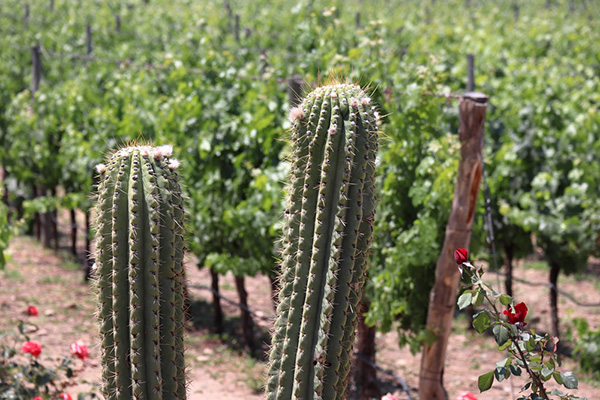
Salta Vineyard Complete with Cactus
The vineyards in Salta are among the highest in the world, with some reaching up to 3,000 meters (nearly 10,000 feet) above sea level. This high altitude provides a unique climate for grape growing, with intense sunlight and rapidly cooling night-time temperatures that help to produce wines with a distinctive character.
The region has a semi-arid climate, with hot summers and cold winters. The high altitude and low humidity help to prevent diseases in the vineyards, making it an ideal place for organic viticulture.
Salta is best known for its aromatic white wines made from the Torrontés grape, which is native to Argentina. However, it also produces high-quality red wines, particularly from the Malbec and Cabernet Sauvignon varieties. The wines from Salta are often noted for their intense color, strong fruit flavors, and high acidity.
Cafayate is the most important wine-producing area within Salta, known for its stunning landscapes and high-quality wines. The town of Cafayate is a popular tourist destination, with numerous wineries that offer tastings and tours.
Jujuy
The Jujuy wine region, located in the far north of Argentina, is one of the most unique and intriguing wine regions in the world.
Nestled in the Andean foothills, it is one of the highest wine regions globally, with vineyards planted at altitudes ranging from 1,600 to 3,500 meters above sea level. This high-altitude location gives the wines produced here a distinctive character and quality.
The Jujuy region is relatively small (only around 45 hectares) compared to other Argentine wine regions like Mendoza and Salta, but it has a rich history and a growing reputation for quality.
The region is home to a number of wineries, including the well-known Bodega El Esteco, which produces a range of wines including Malbec, Cabernet Sauvignon, and Torrontés.
The climate in Jujuy is extreme, with hot days and cool nights. This diurnal temperature variation is beneficial for grape growing as it allows the grapes to develop full, ripe flavors while retaining their natural acidity. The region also benefits from intense sunlight due to its high altitude, which helps to ripen the grapes and concentrate flavors.
The soils in Jujuy are predominantly sandy and well-drained, which is ideal for viticulture. The region's vineyards are often planted on steep slopes, which helps to improve drainage and expose the vines to more sunlight.
In terms of production, Jujuy is a small player on the Argentine wine scene. However, the wines produced here are highly prized for their quality and unique character.
The region is particularly known for its Torrontés, a white grape variety that produces aromatic, floral wines with high acidity.
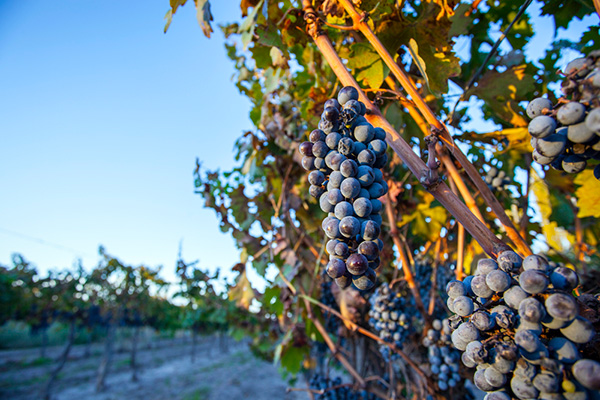
Catamarca
Catamarca, is a mostly mountainous province located in the northwest of Argentina.
This region, though less known compared to its famous counterpart Mendoza, has a rich history and unique characteristics that make it a fascinating place for wine production.
The Catamarca wine region is nestled in the valleys and foothills of the Andes mountains, providing a dramatic backdrop for the vineyards.
The high-altitude vineyards, some of which are among the highest in the world, benefit from the intense sunlight and cool nights.
This diurnal temperature variation is a key factor in producing grapes with a balance of ripe fruit flavors and vibrant acidity, a characteristic that is often sought after in fine wines.
The region's soil is another factor contributing to the unique qualities of Catamarca wines. The vineyards are planted in alluvial soils, which are rich in minerals and have excellent drainage. This type of soil is ideal for viticulture as it encourages the vines to root deeply, which in turn helps them to withstand periods of drought and heat.
Catamarca's wine production is dominated by Malbec, the grape variety that Argentina is most famous for. However, the region also produces excellent wines from other grape varieties such as Cabernet Sauvignon, Syrah, and Chardonnay. The wines from Catamarca are known for their intensity of flavor, full-bodied structure, and ability to age well.
Despite its relatively small size, Catamarca has a diverse range of microclimates, which allows for the production of a wide variety of wine styles.
From the robust, full-bodied reds produced in the warmer, lower-altitude vineyards to the crisp, aromatic whites from the cooler, higher-altitude sites, there is a Catamarca wine to suit every palate.
Calchaquí Valleys
The Calchaquí Valleys, a hidden gem nestled in the heart of northern Argentina, is a wine region that is as captivating as the wines it produces.
This region, known for its high-altitude vineyards, is a testament to the resilience and ingenuity of winemakers who have harnessed the challenging environment to create some of Argentina's most distinctive wines.
The Calchaquí Valleys are located in the provinces of Salta, Catamarca, and Tucumán and the region is named after the Calchaquíes, an indigenous people who once inhabited these lands.
The valleys are a series of interconnected high-altitude plateaus, with vineyards planted at elevations ranging from 1,700 to over 3,000 meters above sea level, making them some of the highest in the world.
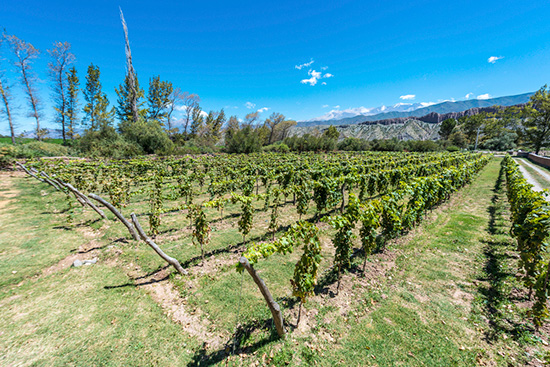
Vineyard in Calchaquí Valley
This altitude provides a unique microclimate that is ideal for grape cultivation, with intense sunlight, cool temperatures, and a significant diurnal temperature variation that helps to preserve the acidity and aromatic complexity of the grapes.
The region is particularly renowned for its expression of the Torrontés grape, a white variety that is considered the signature grape of Argentina.
The Torrontés wines of the Calchaquí Valleys are celebrated for their intense floral aromas, crisp acidity, and elegant structure. However, the region is not limited to white wines.
It also produces exceptional red wines, particularly from the Malbec and Cabernet Sauvignon varieties, which exhibit a depth of flavor and complexity that is a testament to the unique terroir of the region.
In terms of production, the region has over 40 wineries, with a total vineyard area of approximately 3,000 hectares. The annual production is around 20 million liters of wine, with a significant portion of this being exported to international markets.
Cuyo (Central) Region
Located next to the Andes Mountains, this is the true heart of Argentinian wine. Mendoza and San Juan contain almost 95% of wine grape vineyards in Argentina.
La Rioja
La Rioja, a region nestled in the heart of Argentina, is a name that resonates with the melody of fine wines.
The region's viticultural roots run deep, with a history that dates back to the 16th century when Spanish missionaries first introduced grapevines to the area.
The name 'La Rioja' itself is a nod to the region's Spanish heritage, borrowed from the famous wine region in Spain. This homage to its Spanish counterpart is a testament to the region's commitment to wine production, a tradition that has been upheld for centuries.
The region's unique geographical features contribute significantly to its wine production. Situated at the foothills of the Andes, La Rioja boasts a high-altitude terroir.
The vineyards, perched at elevations of up to 1,500 meters, benefit from the cool mountain air, which helps to preserve the acidity and freshness in the grapes.
The region's arid climate, characterized by low rainfall, intense sunlight, and a significant diurnal temperature variation, is conducive to the cultivation of a variety of grape types.
La Rioja is particularly renowned for its production of Torrontés, a white grape variety indigenous to Argentina. The wines produced from this grape are aromatic, with floral notes and a hint of citrus, embodying the spirit of the region in every sip. The region also produces excellent red wines, particularly from the Syrah and Malbec grape varieties.
Contrary to what the name 'La Rioja' might suggest, the region actually grows very little Tempranillo, unlike its Spanish namesake.
In my opinion, what sets La Rioja apart is its commitment to tradition coupled with an innovative spirit. The region has managed to preserve its centuries-old winemaking techniques while also embracing modern technology and practices.
This blend of old and new is reflected in the wines themselves, which manage to strike a balance between tradition and innovation.
Mendoza - The Heart of Argentina's Wine Country
Mendoza is the beating heart of Argentina's wine country. It's Argentina's largest and most important wine region, accounting for nearly two-thirds of the country's entire wine production.
Nestled at the foot of the Andes, its vineyards are bathed in sunlight for over 300 days a year, creating the perfect conditions for producing world-class Malbec.
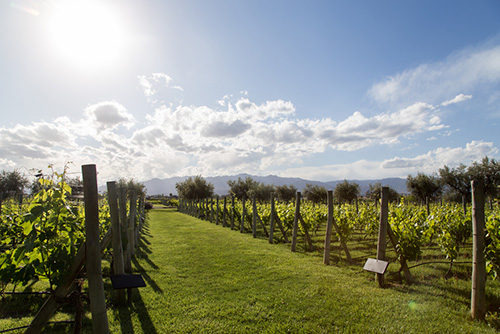
Vineyard in Mendoza
Location and Climate
Mendoza is located in a high-altitude desert, and the region is naturally dry. I know this sounds like a terrible place to grow grapes but being at the foot of such big mountains has a big benefit...
The Andes provide meltwater for irrigation, which is absolutely crucial for viticulture.
The high altitude and abundant sunshine result in a significant temperature difference between day and night, which is beneficial for the grapes as it helps to preserve their acidity and develop complex flavors.
The vineyards in Mendoza are actually some of the highest in the world, with altitudes ranging from 800 meters to 1,500 meters above sea level. The high altitude provides a cool climate that is ideal for grape growing.
Grapes and Wines
Mendoza has the largest concentration of Malbec vineyards in the world. The high altitude and cool climate of Mendoza allow the Malbec grapes to ripen slowly, which helps to create a wine with deep color, rich flavor, and smooth tannins.
Cabernet Sauvignon is the second most planted grape variety in Mendoza. The Cabernet Sauvignon from Mendoza is known for its full-bodied flavor and high tannin content.
Chardonnay is the most widely planted white grape variety in Mendoza. The Chardonnay from Mendoza is typically unoaked and is known for its bright acidity and fresh fruit flavors.
Other grape varieties grown in Mendoza include Syrah, Merlot, Tempranillo, Bonarda, and Torrontés. Each of these varieties contributes to the diversity of wines produced in the region.
Major Regions of Mendoza
Mendoza is approximately the size of Illinois and has over 144,000 hectares of vineyards.
Therefore, it has its own distinct areas with unique microclimates and terroir.
These are the main subsections of the Mendoza wine region.
Maipú
Maipú is one of the most traditional wine regions in Mendoza and is known for its old vineyards and historical wineries. It is located in the eastern region of Mendoza, just south of Mendoza City.
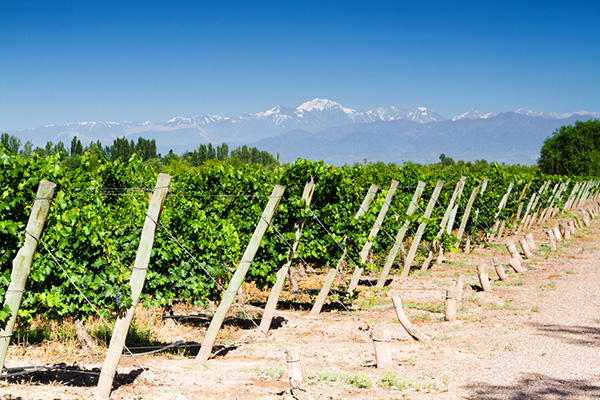
Vineyard in Maipú
Maipú is famous for its Malbec, Cabernet Sauvignon, and Chardonnay wines. The region has a semi-arid desert climate, with hot summers and cold winters, which is ideal for grape cultivation. The soil in Maipú is alluvial with a clayey subsoil, which helps retain water.
Luján de Cuyo
Luján de Cuyo is another important wine region in Mendoza, located on the western side of Maipú, south of Mendoza City.
It is known as the birthplace of Malbec, as it was the first region in Argentina where this grape variety was extensively cultivated.
The region has a high-altitude desert climate, with hot days and cool nights, which is perfect for producing high-quality grapes.
The soils in Luján de Cuyo are alluvial, with a mix of sand, silt, and clay, and are excellent for viticulture.
The region is home to many prestigious wineries and produces some of the best Malbec wines in the world. It was actually the first Argentine wine region to receive DOC status so it is somewhat of a prestigious piece of Argentine wine country.
Uco Valley
The Uco Valley is a wine region located in the southern part of Mendoza Province, near the town of Tunuyán. It is one of the highest-altitude wine regions in Argentina, with vineyards located between 900 and 1,200 meters above sea level.
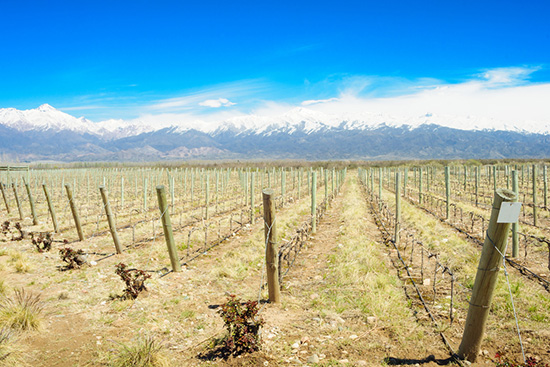
Vineyard in Uco Valley
The region is known for its cool climate, which is ideal for growing a variety of grape types, including Malbec, Cabernet Sauvignon, and Chardonnay.
These days it's one of the most famous wine regions in South America with it's Malbec making wine critics swoon over the unique minerality and acidity it possesses.
The Uco Valley has a diverse range of soil types, including alluvial, sandy, and rocky soils, which contribute to the unique characteristics of the wines produced here.
The region is known for producing high-quality wines with a strong terroir expression. The wines from the Uco Valley are often characterized by their bright acidity, deep color, and intense fruity flavors.
San Juan
San Juan, a region nestled in the western part of Argentina, is a name that resonates with the rhythm of wine production.
The region, named after the capital city of the province, San Juan, is the second largest wine-producing area in Argentina. The name "San Juan" is of Spanish origin, meaning Saint John, a testament to the Spanish influence in the region.
The San Juan region is a fascinating tapestry of diverse landscapes and climates, ranging from the arid desert to the lush green valleys. This diversity is reflected in the variety of wines produced in the region.
The region is known for its production of Syrah, a red wine grape variety that thrives in the warm climate of San Juan. The region also produces a significant amount of Argentina's white wines, including the aromatic Torrontés.
One of the most intriguing aspects of the San Juan wine region is the use of high-altitude vineyards. The vineyards are located at elevations ranging from 600 to 1400 meters above sea level.
This high altitude, combined with the intense sunlight and cool nights, creates a unique microclimate that is ideal for grape cultivation. The result is wines with a distinct character, marked by intense flavors and a high level of acidity.
The San Juan wine region is a testament to the resilience and ingenuity of winemakers. Despite the challenging desert climate, winemakers have harnessed the unique conditions to produce wines of exceptional quality.
The use of high-altitude vineyards is a brilliant adaptation to the environment, resulting in wines that are as unique as the region itself.
Patagonia (South)
The southernmost wine region in South America can be defined by three areas: Río Negro, La Pampa, and Neuquen.
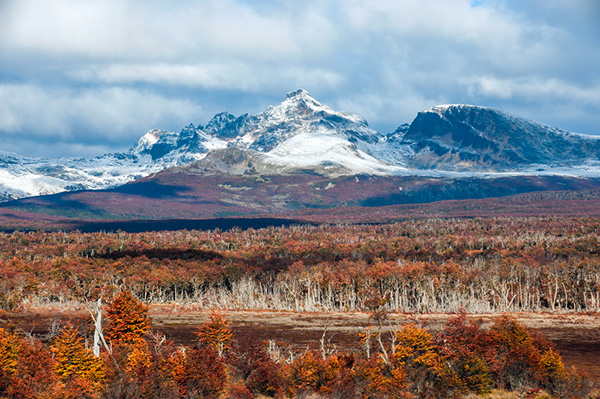
The Stunning Landscape of Patagonia
Río Negro
The Río Negro region, nestled in the heart of Patagonia, Argentina, is a fascinating area that has carved out a unique identity in the world of wine.
The name "Río Negro" translates to "Black River," a moniker that the region owes to the river that flows through it. This river, with its dark, fertile soil, has been a lifeline for the region, providing the necessary irrigation for vineyards to thrive in this otherwise arid landscape.
The Río Negro wine region is a nod to the power of nature and human ingenuity. It is situated in a desert, yet it has been transformed into a thriving viticultural area.
This transformation is largely due to the efforts of early settlers who harnessed the waters of the Río Negro through an extensive system of canals and irrigation ditches, turning the desert into a fertile oasis.
This is a testament to human determination and the desire to create something beautiful and fruitful from a challenging environment.
The wines produced in the Río Negro region are as unique as the region itself. The combination of cool climate, long hours of sunshine, and the mineral-rich soils contribute to the production of wines with intense fruit flavors, vibrant acidity, and a distinct mineral character.
The region is particularly known for its exceptional Pinot Noir and Malbec wines, which are gaining recognition on the international stage.
One of the interesting facts about the Río Negro region is its unique microclimate. Despite being located at a latitude that would typically be associated with harsh, cold climates, the region enjoys a surprisingly mild climate.
This is due to the warming effect of the Río Negro, which creates an ideal environment for grape growing.
Neuquén
The Neuquén region of Patagonia, Argentina, is a fascinating area that has been gaining recognition for its unique wines.
Nestled in the southernmost part of the country, it is a place where the rugged beauty of the landscape is reflected in the character of the wines produced there.
The name "Neuquén" is derived from the Mapudungun language, spoken by the Mapuche people, the indigenous inhabitants of the region.
Neuquén is a relatively young wine region, with the first commercial vineyards being planted in the late 1990s.
Despite its youth, the region has quickly gained a reputation for producing high-quality wines, particularly Malbec and Pinot Noir.
The unique climate of Neuquén, characterized by cool temperatures, strong winds, and a high desert setting, contributes to the distinctive qualities of its wines.
The cool climate allows the grapes to ripen slowly, resulting in wines with excellent acidity and complex flavors.
One interesting fact about Neuquén is its location in the Patagonian desert, one of the driest regions in Argentina.
This might seem like an unlikely place for a thriving wine region, but the presence of the Neuquén and Limay rivers provides the necessary irrigation for the vineyards.
This combination of desert climate and river irrigation results in wines with a unique character that is distinct from other Argentinian wine regions.
In my personal opinion, the wines from Neuquén are truly special. They have a certain freshness and vibrancy that sets them apart.
The Malbecs are not as heavy as those from Mendoza, but they have a wonderful complexity and depth of flavor. The Pinot Noirs, on the other hand, are elegant and refined, with a delicate balance of fruit and acidity.
La Pampa
The La Pampa region, nestled in the heart of Argentina, is a gem in the crown of the country's wine production.
It is part of the larger Patagonia wine region, which is renowned for its exceptional wines. The name "La Pampa" translates to "the plain" in Spanish, a fitting name for this region characterized by its vast, flat landscapes. The plains of La Pampa stretch out as far as the eye can see, a testament to the region's agricultural richness.
The La Pampa region is a relatively new player in the Argentine wine industry. Its emergence in the wine scene is a testament to the adventurous spirit of Argentine winemakers who dared to venture into this previously untapped region.
The unique climate of La Pampa, with its cool temperatures and low rainfall, provides an ideal environment for grape cultivation. This has led to the production of wines with a distinct character, setting them apart from those produced in other regions of Argentina.
One of the most fascinating aspects of La Pampa is its history. The region was once the home of indigenous tribes, who lived off the land long before the arrival of the Spanish colonizers. The influence of these indigenous cultures can still be felt today, adding a layer of richness to the region's identity.
In terms of wine production, La Pampa is known for its high-quality Pinot Noir and Malbec wines. The cool climate of the region allows the grapes to ripen slowly, resulting in wines with a balanced acidity and complex flavors.
The wines from La Pampa are a true reflection of the region's unique terroir, embodying the essence of the land in every sip.
